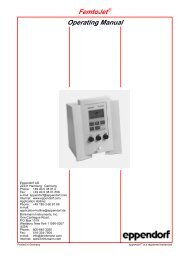DM6000 CFS.qxd:DM6000 CFS - Duke University Light Microscopy ...
DM6000 CFS.qxd:DM6000 CFS - Duke University Light Microscopy ...
DM6000 CFS.qxd:DM6000 CFS - Duke University Light Microscopy ...
Create successful ePaper yourself
Turn your PDF publications into a flip-book with our unique Google optimized e-Paper software.
New XYTZ-Scan Mode for 3D visualization of calcium transientsThe dendritic tree has a complex three dimensional structure.Repeatedly acquiring complete 3D stacks gives a temporal resolutionmuch too low for imaging the fast calcium transients in dendrites.To circumvent this problem, optical sectioning, the fastscanning of the resonant system and the triggering capability arecombined for the new XYTZ-Scan Mode.Individual time series are taken at different focal depths and combinedinto a 4D image stack. A stimulus is always delivered beforethe same frame of each time series, synchronized by a trigger outevent. After a complete focal series, the image data is projectedinto a 3D data stack over time. For each structure in the sampled3D volume the fluorescence transients can be analyzed. The timecourse of fluorescence in all parts of the dendritic tree can beseen clearly.XYTZ-Scan Module:Time series at different focalpositions, stimulus (t 0 ) is always delivered beforethe same frame of each time seriesScanner patching and optimized workflowIn combination with the IR-SGC, which makes electrophysiologyneedles visible in the scanning mode, the extreme speed of theresonant scanner allows electrode patching while imaging atvideo rates, without ever switching to the camera mode. Togetherwith the one-for-all electrophysiology 20x 1.0 objective, scannerpatching minimizes the number of steps between experimentsetup and data collection, optimizing your workflow.So even though you might never need it, the workflow orienteduser interface of the Leica TCS SP5 with Leica <strong>DM6000</strong> <strong>CFS</strong>includes the camera as well. Whether you are doing CCD-cameraor confocal / multiphoton imaging, the other option is always justone fast click away. Integrating both operation modes in the samesoftware allows you to concentrate on what’s in your images, noton where they came from.Features and BenefitsCamera interface• Software-integration of CCDcameraand confocal scanner• Single click switching betweencamera and confocal• Workflow oriented user interface9










